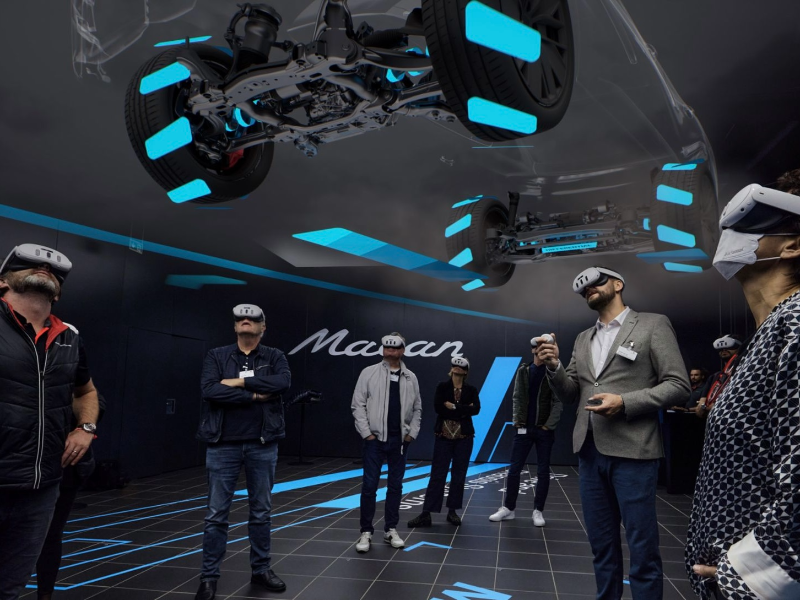- Tethered VR headsets offer high-fidelity experiences by connecting to powerful gaming PCs or consoles, providing immersive VR environments with precise tracking and motion controllers.
- Standalone VR headsets provide untethered experiences, containing all necessary hardware within the headset itself, making them portable and convenient for users to enjoy immersive gaming, entertainment, and social experiences without the need for external devices.
- Mobile VR platforms, such as smartphone-based VR headsets and cardboard viewers, leverage smartphones to deliver basic VR experiences, introducing millions of users to VR technology through affordable and accessible devices that utilise the smartphone’s display and sensors.
Virtual Reality (VR) technology has revolutionised the way we interact with digital environments, offering immersive experiences that blur the line between the physical and virtual worlds. From gaming and entertainment to healthcare and education, VR has found applications across diverse industries, driven by an array of technologies and platforms.
Tethered VR headsets
Tethered VR headsets are among the most immersive VR experiences available, offering high-fidelity visuals and precise tracking capabilities. These headsets are connected to a powerful gaming PC or console via cables, providing the computational horsepower needed to render complex virtual environments in real-time. Examples include the Oculus Rift, HTC Vive, and Valve Index, which offer room-scale tracking, motion controllers, and a wide range of VR experiences, from gaming and simulation to productivity and design.
Standalone VR headsets
Standalone VR headsets offer untethered VR experiences, eliminating the need for a PC or console connection. These devices contain all the necessary hardware, including processors, displays, and tracking sensors, allowing users to enjoy VR content without being tethered to a specific location. Standalone headsets like the Oculus Quest series and HTC Vive Focus offer convenience and portability, making them ideal for immersive gaming, entertainment, and social experiences on the go.
Also read: The history of Virtual Reality (VR) technology
Mobile VR platforms
Mobile VR platforms leverage the computing power of smartphones to deliver immersive VR experiences through affordable and accessible devices like smartphone-based VR headsets and cardboard viewers. These platforms utilize the smartphone’s display and sensors to create basic VR environments, enabling users to explore 360-degree videos, VR apps, and games. Google Cardboard, Samsung Gear VR, and Google Daydream are examples of mobile VR platforms that have introduced millions of users to VR technology, albeit with more limited capabilities compared to tethered or standalone VR.
Augmented reality (AR) and mixed reality (MR)
While not strictly VR, augmented reality (AR) and mixed reality (MR) technologies share similarities with VR and offer unique experiences that blend virtual and real-world elements. AR overlays digital content onto the physical environment through devices like smartphones, tablets, and AR glasses, enhancing real-world interactions with digital information and experiences. Mixed reality (MR) takes this concept further by seamlessly integrating virtual objects into the real world, enabling interactive and immersive experiences that combine the best of both worlds. Examples include Microsoft HoloLens, Magic Leap, and ARKit/ARCore-enabled smartphones, which are used in industries ranging from gaming and entertainment to education and enterprise.
Also read: AR and VR technology in healthcare
Web-based VR
Web-based VR allows users to access VR experiences directly through web browsers, eliminating the need for dedicated VR hardware or software. By leveraging technologies like WebVR and WebXR, developers can create VR content that runs on a wide range of devices, from desktop computers and smartphones to standalone VR headsets. Web-based VR offers accessibility and ease of use, enabling users to explore VR content without installing additional applications or plugins, making it ideal for educational, informational, and entertainment purposes.
The diverse types of VR technology cater to a wide range of preferences, needs, and use cases, offering immersive experiences that continue to push the boundaries of what’s possible in the digital realm. Whether tethered, standalone, mobile, AR, MR, or web-based, VR technology holds the promise of transforming how we work, play, learn, and interact with the world around us.

